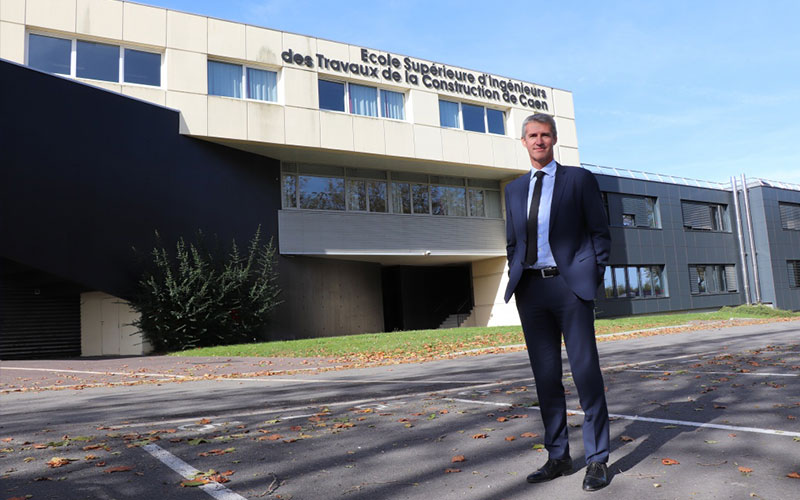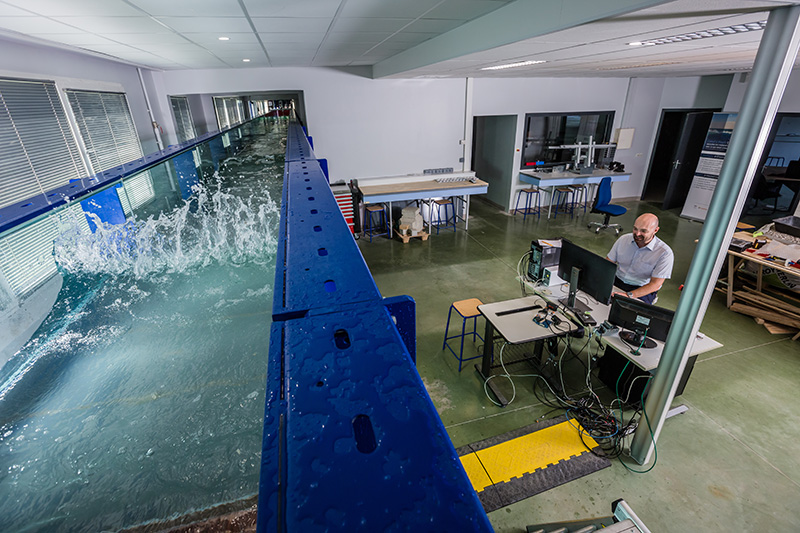What do people know about engineers in the construction sector and in particular in what the French know as Bâtiment Travaux Publics (BTP), or construction and public works? Often not that much! Yet this sector encompasses a whole array of rewarding possibilities, professions and challenges. Covering matters such as full employment, international attractiveness and sustainable development, here we focus on the work of ESITC Caen, the École Supérieure d’Ingénieurs des Travaux de la Construction, a prestigious specialist graduate school for engineers in construction, training the engineers of the future.

Vocation(s)
Created by and for businesses in the construction sector, ESITC Caen is a private higher education institution established in the general interest, managed by an association. Its mission? To find new ways to build, something that companies in the sector are crying out for. ‘‘Construction companies are taking on more and more engineers, have reviewed their recruitment methods and are in search of people with the appropriate skills,’’ emphasises the school’s director, Jérôme Lebrun. French students applying need to have taken science studies at school (Bac S, STI 2D or a CPGE Scientifique) or to have achieved a first technical, vocational higher education qualification (DUT Génie Civil or BTS Bâtiment ou Travaux Publics). ESITC Caen is set on attracting varied types of students for what is a highly progressive curriculum: ‘‘Students decide on the first option they wish to go for at the end of the third year, choosing either construction or public works. Specialisation begins in the fifth year. This allows students to make their choices according to what branch most appeals.’’
Our students don’t have to look for a job, they choose the job that suits them
The main prerequisite is a desire to work in construction and structural engineering. And as construction is no longer carried out today as it was in the past, internationalisation, digital studies, the environment and management are taught alongside science and technology to give students a fully rounded training. The School’s ambitions are strong and realistic: since its creation 25 years ago, over 90% of students each year sign a work contract even before they’ve received their degree. ‘‘There’s work available all around in this sector: in France, in regions across France, or then abroad. Everywhere, companies are looking for this skills set. There are construction projects across the world where specialists are needed to deal with complex specifications.’’ Two major branches are focused on in particular in the School’s curriculum: conceiving projects as an engineer in a design office or consultancy; or then working on the ground, as a works engineer, acting like a conductor, bringing together harmoniously all the elements on a building site. ‘‘What’s more, students can effectively choose the job of their dreams by being in control of three dimensions: the place where they’re going to work, the type of job they’re going to do, and the type of company they’re going to work for!’’ Jérôme Lebrun stresses.
In Normandy, we know how to act collectively !
Opening(s)
With its proven track record in teaching geared to the many needs of the profession, ESITC Caen has also been widening its openness to related institutions. ‘‘We’ve been working more and more on partnerships with other establishments nearby,’’ the director underlines. A member of the Normandie Tech network, bringing together all the engineering schools and schools of architecture across the region, ESITC Caen is also now home to a skills centre dedicated to BIM (Building Information Modelling) that’s unique in France. It was developed in association with the Academy and the Lycée Laplace. Offering some 100 places, this indispensable tool for today’s sector provides the possibility for the different players in civil engineering – schools of architecture, professionals, vocational futher education colleges – to work remotely on digital 3D models.
‘‘Lots of our teachers are professionals in the sector and our students can accumulate up to 16 months of work placements,’’ continues the director. The School’s openness also extends to the international stage. Besides work experience or work placements lasting a minimum of three months, students can also opt to complete their training abroad, working for several months on specific skills. ‘‘We’ve developed a network of partnerships with foreign universities, allowing us, in turn, via the setting up of workshops, to welcome students from around the globe to train in our particular areas of expertise.’’ These exchanges, for example with Germany, Brazil, Vietnam and Gabon, prove beneficial to all, enabling students to discover the processes of construction specific to different geographical regions.
We provide our students with this range of knowledge so that they leave with state-of-the-art baggage with which they can take on the world of work
Sustainable development(s)
‘‘In the past, people expected a building to be sturdy, above all. Today, people want buildings to be aesthetically pleasing, but also to perform well in terms of thermal, acoustic and sanitary criteria… as well as their being durable, that’s to say, planned for a whole life cycle, including recycling…,’’ says Jérôme Lebrun analytically. ESITC Caen has placed a great deal of importance on its research and development activities. Research topics are led by the needs of the profession, which very often cross over with the needs of the region. The School also offers a specialist masters linked to one of the fields of expertise of its laboratory – eco-materials: ‘‘Working with seashells or flax fibre reinforced concrete allows us to demonstrate our closeness to the Normandy Region. A few years ago we also worked on the reuse of sediment dredged from our ports in road construction.’’ All the research projects, linked to universities or in the context of European projects, are developed and tested at the heart of the School, thanks to cutting-edge equipment.

One training specialisation option available in the 5th year – forming part of a second masters degree – focuses on maritime structures, and in particular on renewable offshore marine energy. Since June, the School has been home to a 40m-long wave flume, or canal, unique in France, helping to measure the impact of storms on coasts and on maritime structures. ‘‘This is in response to the major environmental challenge facing us, notably due to planetary warming and the rise in the level of the world’s oceans,’’ the director emphasises. For the use not just of the students, but also of researchers and professionals from around the world, this versatile piece of equipment makes it possible to run very precise simulations. ‘‘Thanks to its active absorption wave generator, we can, for instance, programme exactly where a wave will break.’’
ESITC Caen in brief :
- A non-profit-making private graduate school (set up under the French 1901 law of association), ESITC Caen (the Ecole Supérieure d’Ingénieurs des Travaux de la Construction, or Graduate School of Engineers in Construction Works) was created by and for businesses in the construction sector some 25 years ago. It is accredited by the State (EESPIG) and is a member of the Conférence des Grandes Écoles (an association of prestigious French graduate schools)
- ESITC Caen extends across 10,000m2, following the doubling of the School’s surface area in 2016, the works financed by the Fédération Nationale des Travaux Publics and other groups that participated in its creation: the Normandy Region, the Conseil Départemental du Calvados (or Calvados County Council) and Caen-la-Mer
- It accepts 580 students at any one time and has some 40 permanent staff, plus almost 180 part-time staff, most of them professionals in the sector. Since the extension, the School has grown from taking 100 students a year to 160 students, thanks to the authorisation of the CTI, the Commission des Titres d’Ingénieur, the official French body responsible for evaluating and accrediting higher education institutions specialising in engineering in France
- Students come from across France and from abroad. At the end of their studies, there’s a positive balance between the number of students who’ve come to study here in Normandy and the number who stay on to work in the region
- At the end of their studies here, two out of three students head out to work on site as works engineers while one third find employment in engineering consultancies, with 20% of the total going to work abroad
- Since 2019, the School boasts a wave flume, or canal, that’s unique in France given its dimensions: 40m in length, 1m in width, and 2m in height. Its uses? To anticipate the need for coastal protection, to evaluate and adapt relevant structures and infrastructure, to respond to tomorrow’s energy challenges, to train engineers in the field and to support French businesses
- Thanks to its workshops, some 60 international students come to the School for a period of a month to work with professionals on themes linked to ESITC Caen’s specific areas of expertise
- In the context of two specialist masters degrees (to train as an expert in maritime and port structures, or as an expert in eco-materials and BIM), every year the School also attracts some 15 students from across the globe, be they engineers choosing a specialisation or professionals wishing to add to their skills set
- Besides teaching technical and scientific subjects, the School has also made it compulsory for students to take classes in management, digital technology, languages and the environment.
- What with both State and School bursaries available, one student in three is assisted financially, while one in two is on an apprenticeship
